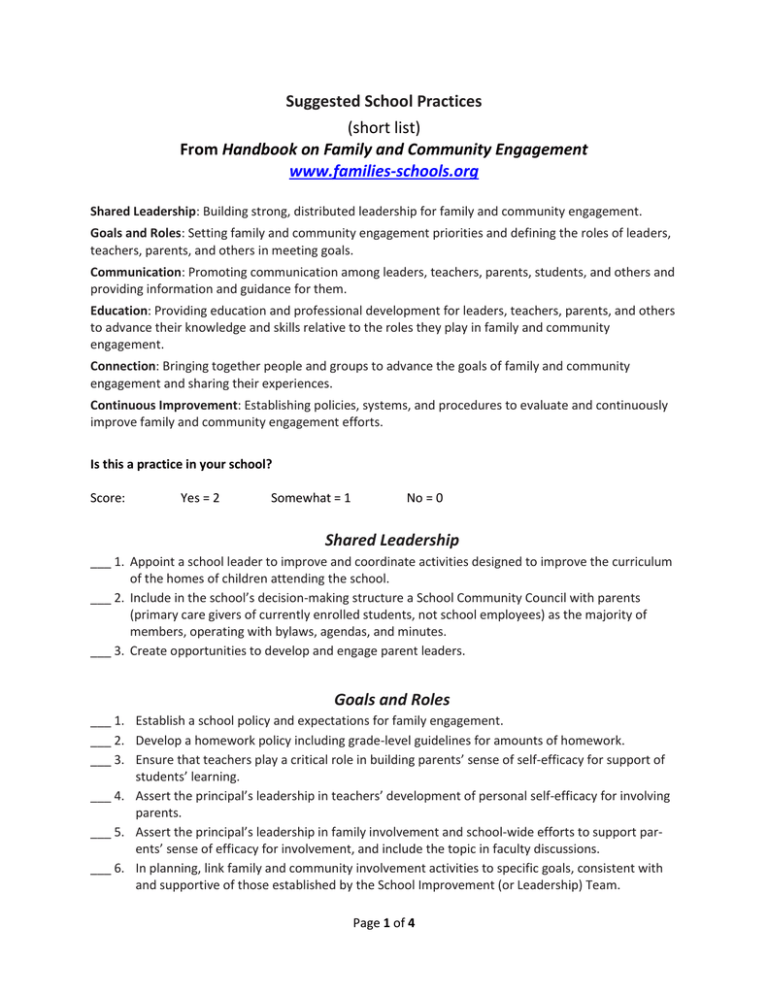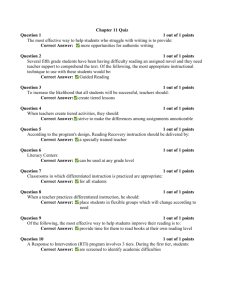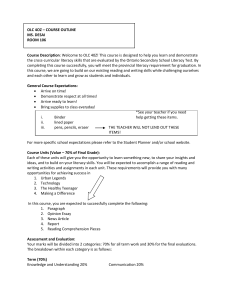Suggested School Practices (short list) Handbook on Family and Community Engagement
advertisement

Suggested School Practices (short list) From Handbook on Family and Community Engagement www.families-schools.org Shared Leadership: Building strong, distributed leadership for family and community engagement. Goals and Roles: Setting family and community engagement priorities and defining the roles of leaders, teachers, parents, and others in meeting goals. Communication: Promoting communication among leaders, teachers, parents, students, and others and providing information and guidance for them. Education: Providing education and professional development for leaders, teachers, parents, and others to advance their knowledge and skills relative to the roles they play in family and community engagement. Connection: Bringing together people and groups to advance the goals of family and community engagement and sharing their experiences. Continuous Improvement: Establishing policies, systems, and procedures to evaluate and continuously improve family and community engagement efforts. Is this a practice in your school? Score: Yes = 2 Somewhat = 1 No = 0 Shared Leadership ___ 1. Appoint a school leader to improve and coordinate activities designed to improve the curriculum of the homes of children attending the school. ___ 2. Include in the school’s decision-making structure a School Community Council with parents (primary care givers of currently enrolled students, not school employees) as the majority of members, operating with bylaws, agendas, and minutes. ___ 3. Create opportunities to develop and engage parent leaders. Goals and Roles ___ 1. Establish a school policy and expectations for family engagement. ___ 2. Develop a homework policy including grade-level guidelines for amounts of homework. ___ 3. Ensure that teachers play a critical role in building parents’ sense of self-efficacy for support of students’ learning. ___ 4. Assert the principal’s leadership in teachers’ development of personal self-efficacy for involving parents. ___ 5. Assert the principal’s leadership in family involvement and school-wide efforts to support parents’ sense of efficacy for involvement, and include the topic in faculty discussions. ___ 6. In planning, link family and community involvement activities to specific goals, consistent with and supportive of those established by the School Improvement (or Leadership) Team. Page 1 of 4 ___ 7. Emphasize the importance of families’ home involvement to children’s school success. ___ 8. Include in the school budget a line item for family engagement with a portion allocated for the training and support of parent leaders. ___ 9. Establish school transition teams that include parents to assist in student transitions between schools and beyond school. Communication ___ 1. Provide specific, accessible information, guidelines, and resources to help parents help their children with assigned homework. ___ 2. Communicate regularly about homework expectations and respond to student and family concerns as issues arise. ___ 3. Share homework challenges and successes with colleagues over the course of the school year and coordinate assignments across teachers or subjects to avoid overburdening students with multiple projects simultaneously. ___ 4. Establish a predictable communication routine with families, including: (a) contacting families before the school year starts to let them know that school personnel are looking forward to working with them as partners in educating their child; (b) offering who the point person/s will be for the year, as well as the best ways to contact them; (c) setting up times or intervals for regular communication; and (d) any information pertaining to the review or reevaluation of the child’s progress. ___ 5. Establish regular, bidirectional communication mechanisms between home and school, such as two-way home–school notes. ___ 6. Use multiple means of communicating with parents (websites, notes to home, bulletin boards, face-to-face meetings, home visits) that are two-way, allowing for parental input and feedback. ___ 7. Provide parents with specific ways through which they can help the child at home, including. concrete suggestions about how to handle academic and behavioral issues. ___ 8. Create a specific community relations plan that involves two-way communication with parents. Education Family Education ___ 1. Initiate school-based parenting classes that teach parents how to: (a) raise expectations of their children and (b) speak and act in a way that is supportive of their children and their accomplishments. ___ 2. Conduct an in-school workshop series for parents on improving the curriculum of the home. ___ 3. Provide an array of literacy activities/workshops for parents and their children within the school setting focusing on the particular skills that their child should be acquiring in reading and literacy so that learning becomes a shared experience. ___ 4. Set your scope and sequence for family education programs. ___ 5. Provide programs to help parents understand how to support their children’s education; in immigrant communities, these should be run by parents from those communities to the extent possible. Page 2 of 4 ___ 6. Offer workshops for parents to learn about and discuss their role in their child’s education, including studying at home, reading at home, parent–child interaction, school–home compact, and learning standards. ___ 7. Train and use parents as leaders in family education programs. ___ 8. House parent educators within the school. Professional Development for School Personnel ___ 1. Train teachers and administrators to become more familiar with the research on parental involvement. ___ 2. Conduct workshops for teachers and other educators on the home curriculum. ___ 3. Provide professional development for teachers about family engagement in homework. ___ 4. Provide professional development for teachers on family engagement and working with parent leaders. ___ 5. Conduct service seminars for teachers and administrators on the processes linking poverty to family relations and children’s outcomes. ___ 6. Provide professional development for faculty and staff to build their capacity to work effectively with students’ families. ___ 7. In schools with Native American students, train all staff on Native American culture, effective relationships with families, and the importance of children’s social and emotional development, and expect the training to be demonstrated in daily work. Connection ___ 1. Provide a welcoming environment, coupled with engagement that is meaningful and varied in format and timing, to increase access for and participation by families. ___ 2. Partner with community agencies to address families’ own barriers to literacy, offering family literacy classes and other adult education opportunities. ___ 3. Create opportunities for schools, libraries, religious groups, and other community-based organizations to collaborate and promote communitywide initiatives that highlight the everyday importance of reading. ___ 4. Connect with a library with a qualified librarian accessible throughout the school day and after hours for family members as well as students. ___ 5. Provide a readily accessible and visible facility to be a family resource center, organized by a coordinator. ___ 6. Invite parents to an annual student-led conference. ___ 7. In schools with immigrant populations, hire or seek volunteers for parent liaisons who can connect the school to the local immigrant communities. ___ 8. Create a safe and welcoming space for parents to meet, and provide an attractive activity that will bring them in. ___ 9. Partner with and invite parents to get involved in the school community; identify a parent liaison to help facilitate language and cultural barriers through different venues (i.e., newsletters, conferences, meetings, events, etc.). ___ 10. Incorporate relevant events, projects, and curriculum that value ethnic diversity (combined with academic rigor and high expectations). Page 3 of 4 ___ 11. Solicit and establish community involvement in the implementation of family intervention and prevention programs. ___ 12. Build relationships with formal and informal child-care providers in the community. ___ 13. Establish a “family space” within the school, with resources for families, a schedule of events, and open times for parent–parent and parent–teacher interactions. ___ 14. Create a structure for parent–teacher meetings that allows for sharing of information, goals, plans, and solutions for all children, and especially those developing learning or behavioral challenges. Continuous Improvement ___ 1. Conduct ongoing and end-of-year evaluations of family engagement programs and practices. ___ 2. Include parents on appropriate school teams and groups and/or seek their input in decisions made by school teams and in plans for school improvement. ___ 3. Conduct a homework inventory and identify various purposes in assignments; edit or discard unsuccessful assignments, and consider ways to make homework more enjoyable. ___ 4. Evaluate the strength of homework assignments and policy through student achievement and student and family feedback; revise and improve each year. ___ 5. Assess the parent involvement climate with surveys, focus groups, and interviews. ___ 6. Disseminate and utilize research to provide knowledge and tools for teachers, counselors, and parents (i.e., workshops, training programs, college access info, ESL classes for parents); focus on alterable factors. ___ 7. Select and evaluate all staff based on their ability to work effectively with families and to attend to the social and emotional development of their students. Page 4 of 4



